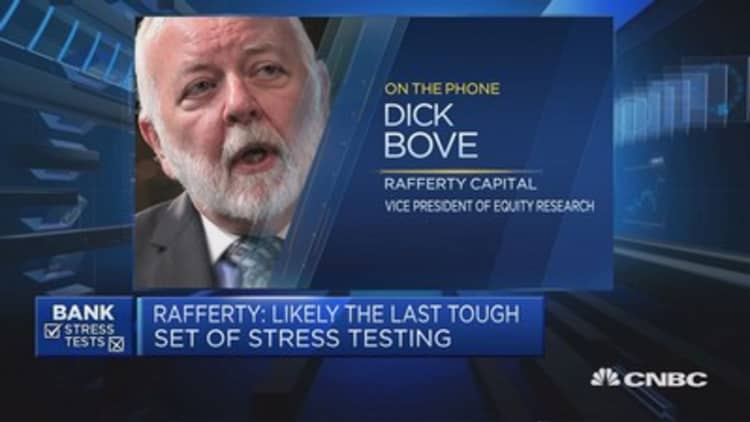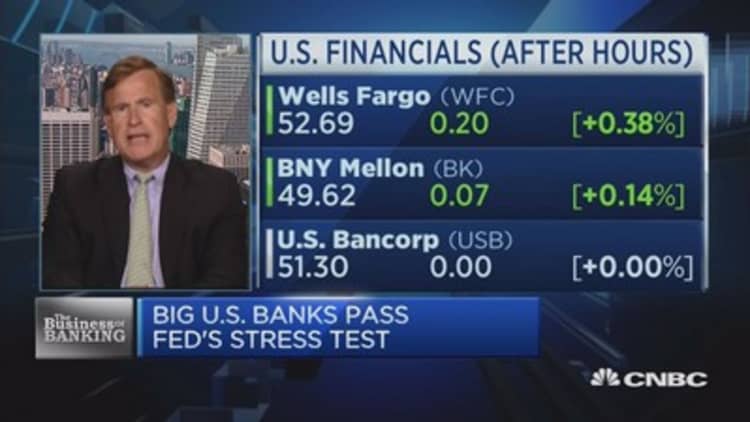
While all of the banks involved in this year's stress tests appeared to pass at least theoretically, winners and losers will emerge in the race to return capital to shareholders.
Bank stocks Friday moved lower, a day after the Federal Reserve released results of its annual measure of financial institutions' ability to withstand crisis scenarios. The sector went from being the market's strongest performer at the open to one of the biggest drags as investors and analysts digested the test results.
The Fed doesn't officially give banks pass or fail grades on the Dodd-Frank Act Stress Tests, or DFAST. Instead, it uses them as a baseline for a second round of analysis that determines whether plans to return capital to shareholders will be approved.
Analysts roundly expect a substantial increase in cash payouts this year compared with 2016.
"Apart from several exceptions, most results were largely in-line with our expectations," Compass Point Research analysts said in a note. "The results reinforce current market expectations for higher combined payout ratios in this year's cycle."
The market will be watching one key metric closely — how many banks will return more than 100 percent of earnings. In essence, that means those banks will dip into cash reserves for payouts, a key measure of their own confidence as well as that of regulators in the institutions' safety.
Of the 34 banks that participated in DFAST — the number will be slashed to 13 next year — consensus is that 10 or 11 of them will exceed the 100 percent threshold, up from just four in 2016.
Some of the big winners in terms of payout ratios look to be Regions Financial [124 percent], Citigroup [124 percent] and Discover Financial Services [114 percent], according to projections from Goldman Sachs. Keefe, Bruyette & Woods adds Goldman [136 percent] to the list of big payers and forecasts the payout ratio for CIT Group to be a gaudy 157 percent.
However, KBW concedes that after seeing the test results, its estimates may be too optimistic for some banks.
Goldman "may not have the capacity to meet our bullish capital return forecast, but the capital buffer in DFAST may be enough to meet the consensus forecast for capital return," KBW said. Morgan Stanley was another bank mentioned as possibly running into some roadblocks with its capital payout plans.
Fitch Ratings said the results to be released Wednesday — formally known as the Comprehensive Capital Analysis and Review — "will be broadly neutral for the banks. However, some banks have not fared as well in recent years, and a secondary qualitative fail could result in negative ratings pressure."
One of the stumbling blocks could be a new wrinkle added this year called the supplementary leverage ratio — the bank's top-tier capital divided by its total leverage exposure. All banks eclipsed the Fed's mandated 3 percent level, but several of them cut it close.
Morgan Stanley had the lowest level at 3.8 percent, while Goldman was next at 4.1 percent and State Street had a projected 4.2 percent level. Morgan Stanley and State Street declined to comment while Goldman did not immediately respond to a request for comment. Analysts generally still expect all three banks to have strong payout ratios.
The best news for the banks, though, may be that this is likely the last year the tests will be this difficult. With a press for deregulation in the Trump administration and some rules already in place that will relax the rules, the road should get smoother ahead. One proposal is to have the tests limited to every two years.
"In general, we expect future stress tests will be less onerous since the Fed is expected to disclose more about the process and CCAR banks should remain very well capitalized even with our expectations for higher return in the upcoming CCAR," KBW said.
Watch: Changes are on the horizon for the way the Fed stress tests banks
.



